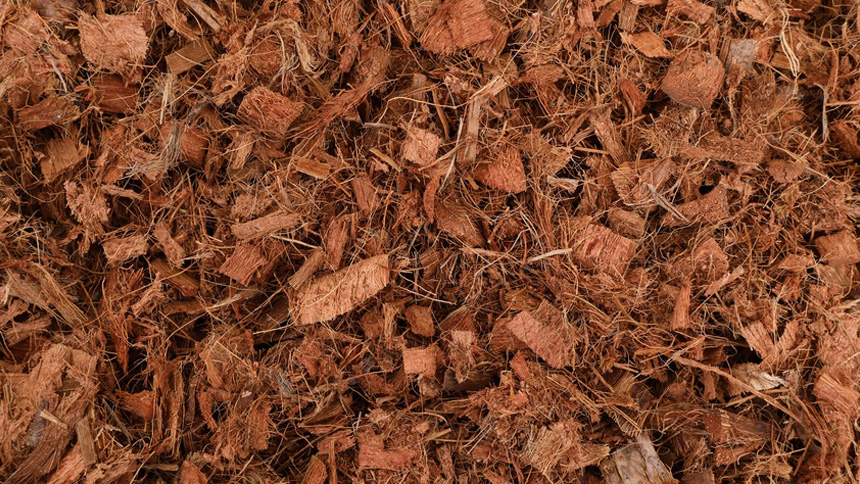
Substrate Guide for Frog Enclosures
Finding the perfect substrate for your terrarium can seem like a daunting task. Whether you’re in need of soil to support live plants or you’re just using fake plants, this guide is meant to help you get started.
I’ll start by explaining the difference between a substrate used in a ‘terrarium’ and in a ‘vivarium’. Although these two terms are generally misused nowadays, I will go on to explain what is most often utilized in both setups.
One thing you might be wondering is why I don’t mention traditional mulch or even sand. While there are plenty of substrates to choose from, the ones listed below are the kinds I personally like. And they’re most suitable for frogs, but they will work for some reptiles as well.
Also, these substrates are considered safe from causing impaction. Impaction occurs when an animal accidentally eats something it can’t digest. Take aquarium pebbles, for example.
If your frog eats a cricket and accidentally eats a small piece of rock, the cricket will be digested but the rock will not. Over time, this buildup will lead to health problems and often results in death. While sand can be impacted, it’s generally safe to use when mixed with other substrates.
So, now you know why I haven’t listed every substrate imaginable. The substrates listed below are generally considered safe for frogs and other amphibians. They’re widely available, fairly popular, and I like them. So let’s get into it.
Page Contents
Which substrate do I need? Terrarium? Vivarium?
In the reptile and amphibian world, the terms “Terrarium” and “Vivarium” are essentially umbrella terms for enclosures containing cold-blooded creatures. Technically speaking, however, a terrarium is an enclosure containing plants and soil; no animals.
Once you place an animal in a habitat, it becomes a vivarium. You may be wondering what this has to do with the substrate. I will get to that, I promise. Just keep reading.
Your average hobbyist nowadays refers to terrariums as empty containers meant for housing reptiles or amphibians. In most cases, fake plants will be used but, depending on who you talk to, it can contain real plants too. Where the enclosure transitions from a terrarium into a vivarium in kind of a gray area. At least nowadays. And depending on who you talk to.
When most people reference a vivarium nowadays, they’re talking about a terrarium with live plants, animals, possibly a drainage layer, and a clean-up crew, known as Microfauna. Microfauna usually consists of springtails and isopods. This is what I consider a “bioactive” environment.
So, to keep things simple, let’s just say a terrarium is an enclosure with fake plants, some decorations, and, of course, your pet frogs. We will call a vivarium an enclosure with live plants, frogs, some decorations, and microfauna. Now that we’re on the same page, it’s easy to see which type of substrate you need.
Do you need the substrate to support live plants and microfauna? Just real plants? Perhaps you don’t need either. That’s fine, too!
For terrariums, a substrate that doesn’t need a lot of nutrients to support live plants, check out the substrates listed in the first section below. For vivarium substrates, seek out the information in the following section labeled “Bioactive Vivarium Substrates”.
Terrarium Substrates
Most terrarium substrates aren’t packaged with plant growth in mind. They will, to a certain extent, support live plant growth but that’s not their forte, so to speak. Should you decide to use fake plants in your frog’s enclosure, then hey, your average terrarium substrate will work perfectly. That’s what this section covers.
Coconut Fiber
Coconut fiber substrate is easily the most popular substrate for amphibians. It’s made from the husks of coconuts, it’s cheap and readily available. It’s also known as Coir and has many uses.
For horticulture use, it’s second to none in terms of water retention. As for availability, well, you can find it online, in pet stores, and home improvement stores.
As for the brands targetting the pet market, you can find loose or compressed bricks of coconut fiber. Zoo Med’s Eco Earth is reputable for being one of the best on the market. I’ve heard wonderful things about Exo Terra’s Plantation Soil as well.
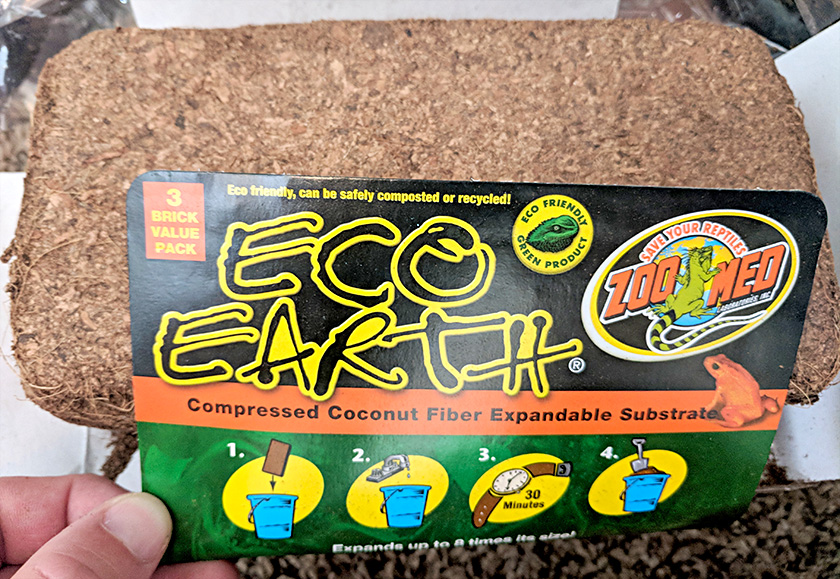
For use in terrariums, coconut fiber substrate is one of the best options available. I highly recommend it. It can be used by itself or added to others to create a more specialized substrate. See Eco Earth on Amazon →
Coco Husk
Very similar to the previous substrate, this one is also made from coconuts but in the form of chips. Like wood chips, only it’s made from the husk of coconuts. It’s suitable for retaining moisture as well as creating air pockets for plant roots to grow. They’re soft and fibrous and generally considered safe for all amphibians. Coco husk is often used in custom substrate blends.
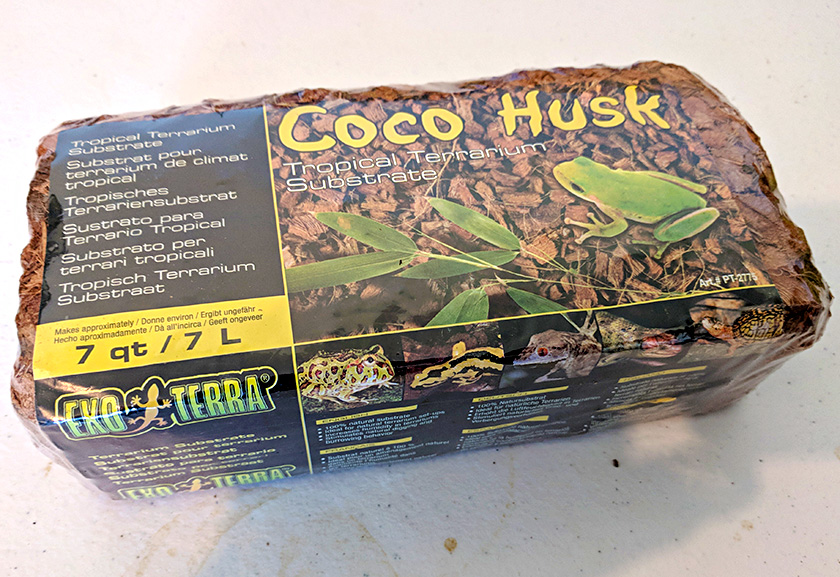
Exo Terra makes a compressed coco husk brick you can find for $10 – $15.
Soil
Topsoil is different depending on where you live in the world. In the United States, it’s easy to buy a bag of soil. Where I live, a 40 lb bag of topsoil costs just a little over $2. I don’t recommend using only dirt as your substrate.
It’s not suitable for most habitats because it’s bad at retaining moisture. In humid environments, or whenever water is applied, it turns into mud and tends to dry out hard and compacted.
Soil is great but it’s best utilized when mixed with vermiculite, sand, sphagnum moss, and other items. By the way, always ensure the soil you’re using is free from chemicals and pests.
Should you go outside a dig up some dirt from your backyard, you run the risk of the soil harboring unwanted pests. These pests won’t bother the local animals, but they may be dangerous to the ones you’re keeping.
Moss
Using terrarium moss has its benefits, mainly in moisture retention. For those of you having a hard time retaining high humidity levels in your terrarium, try mixing some sphagnum moss into the substrate.
It soaks up water like a sponge. Having lots of water in your substrate helps keep the humidity levels high in your terrarium. To clarify, the moss I’m referring to is not a decorative moss that sits on top of rocks or tree branches. These mosses are meant for mixing in the substrate.
The majority of moss used for terrarium substrate is sphagnum moss. It’s not used on its own, rather it’s mixed in with another substrate like coir (coco fiber).
In some cases, people will clump sphagnum moss in a corner or in a bamboo humidifier to create a humid hiding place. It’s kind of expensive, so use it wisely. Also, Exo Terra has a new forest moss but I haven’t tried it yet. Let’s hope it’s a great alternative to sphagnum moss.
Mixes
Just like every industry, the pet trade is filled with companies competing for your business. So, as you can imagine, there are a handful of different substrate mixes available.
Most of them are a combination of the substrates listed above. Soil, moss, coconut fiber, and more. I haven’t tried them all so I won’t recommend one over the other. I’m sure they’re all good substrates.
If you want my recommendation, I would pick up a 3 pack of eco earth or plantation soil and call it good. Especially if you’re using fake plants and you just need a soft, safe substrate for your frogs.
Bioactive Vivarium Substrates
A good vivarium substrate drains properly while retaining the right amount of moisture, has the nutrients your live plants need, and contains beneficial microorganisms to help break down waste. The substrate needs to support a clean-up crew to remove waste and add nutrients back into the soil so your plants can grow.
As the plants use up all the nutrients, you’ll need a way to add some back into the substrate. This is usually accomplished by adding leaf litter and sphagnum moss. It’s a balanced ecosystem in which all elements work together to create a bioactive environment. And it all starts with the drainage layer.
Drainage Layer
A drainage layer allows excess water to run through the substrate. The water collects on the bottom of the terrarium, below the substrate. This is important, the substrate shouldn’t be set in water. A soggy substrate can lead to other problems. So, we create a false bottom and separate the bottom from the substrate with a barrier. The water drains through the substrate barriers and into the false bottom. I’ll show you how to do it.
False Bottom
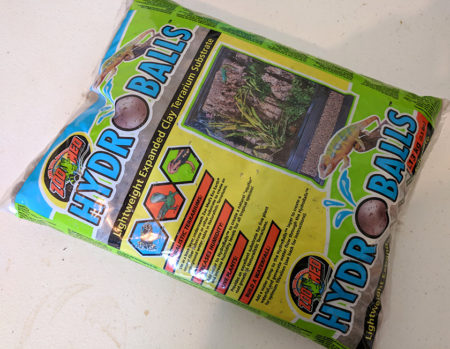
The false bottom is where all the excess water collects. It should be deep enough to contain at least 2 inches of water. Perhaps the most popular item used in creating a false bottom is hydroballs. Hydroballs are expanded clay balls. Depending on the size of the enclosure, you may need 1 – 3 bags. Another option is Matala filter. This is my favorite. It’s meant for coy fish ponds but works great as a false bottom. It’s bendable and you can cut it to the dimensions you need.
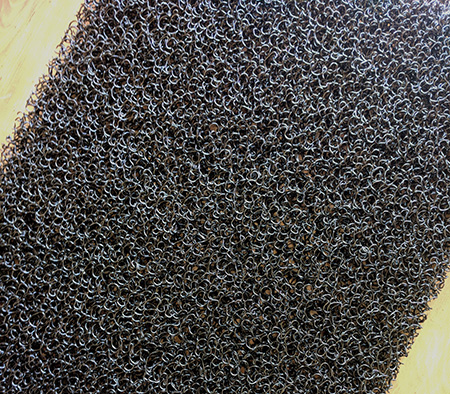
So, the first step is to place your false bottom down, whether you use hydroballs or Matala filter. Once finished, you need to cover the false bottom with a substrate barrier.
Substrate Barrier
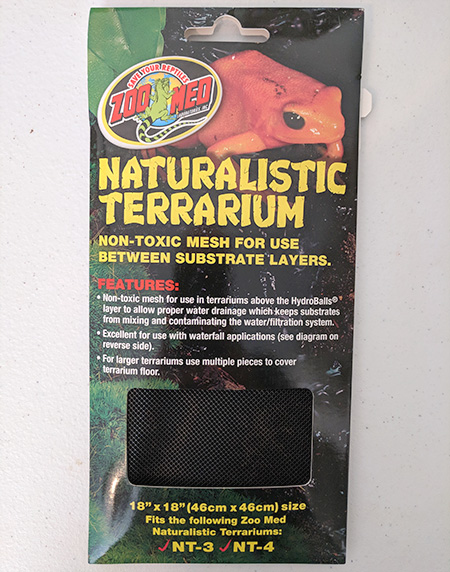
The next step is to place a mesh barrier on the false bottom. Zoo Med makes a “Naturalistic Terrarium Substrate Mesh” product specifically for this. But I imagine weed-barrier from Lowes would do the exact same thing and, for roughly the same price, you get so much more. Like hundreds of feet more.
So long as it won’t allow the substrate to pass through, but it will allow water to pass through, you’re good to go. Another thing, don’t use window screen because it’s made from aluminum. Metal screens will rust and break down over time, leaving you with a mess to clean up.
Once you’ve got your false bottom in place and have a mesh barrier covering it, you can place your substrate on top.
Substrates
You can find vivarium substrate recipes all over the internet. While some are better than others, most of them are based on the same ingredients; lump charcoal, sphagnum moss, fern, orchid bark, and peat moss.
Something you’ll hear a lot about is the ever-popular “ABG mix”. ABG stands for Atlanta Botanical Garden and it’s a mixture of peat moss, sphagnum moss, charcoal, tree fern, and orchid bark.
There are many variations of ABG mix made by a variety of companies. All of which are very similar. Here is a popular ABG mixture recipe.
Basic ABG Mix Recipe
- 1 part peat moss
- 1 part sphagnum moss
- 1 part lump charcoal
- 2 parts tree fern
- 2 parts orchid bark
Combine these ingredients to create your own ABG mix.
Mix the following items together and you’ll have one of the all-time best vivarium substrates for growing plants. It’s also great for supporting springtails and Isopods, which will be covered in the next section.
Should you decide to make your own, you’ll save some money in the long run. Especially if you’re going to use a lot of this. Having one or two frog enclosures, however, it might be more practical to buy a pre-made ABG mix.
Remember, this is great for real plants but you still need a clean-up crew and you’ve got to add nutrients back into the soil, that’s where leaf litter helps. Keep reading for more information.
Springtails and Isopods

Microfauna is the clean-up crew for your substrate. They feed on frog droppings, decomposing leaf litter, dead plant material, mold, and fungi. They’re essential for the health of a vivarium.
Introducing springtails and isopods into your vivarium takes time. That is, it takes time for the starter culture to establish within the vivarium. I recommend giving your microfauna a month to settle in and establish before adding frogs into the enclosure.
Leaf Litter
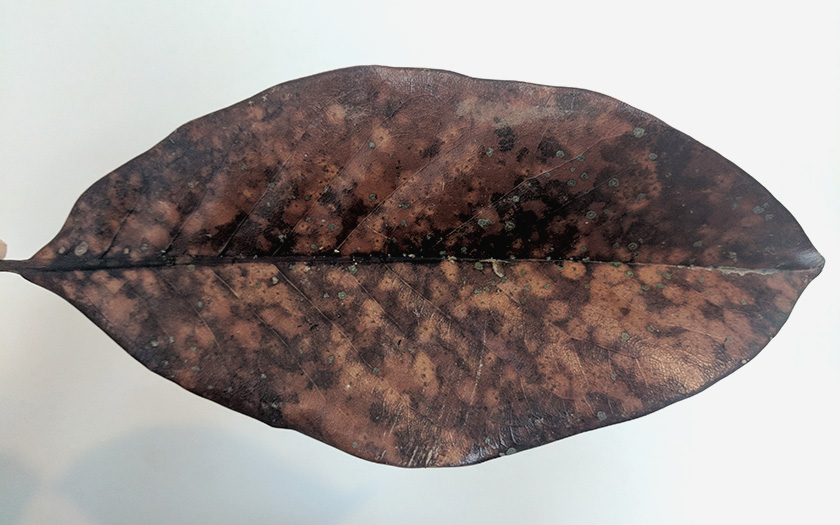
Adding leaf litter to your vivarium does several things, all of which are important. As the leaves decompose, they add nutrients back into the soil. It provides food for your microfauna and last but not least, it provides hiding places for frogs. Leaf litter is great for poison-dart frogs, toads, and burrowing species.
The most popular leaves come from Magnolia trees. They’re massive in comparison to most leaves. Aside from magnolia leaves, oak and Indian almond leaves are popular too. These leaves are popular because it takes a long time for them to decompose.
Conclusion
There is more to learn about substrate than what is mentioned here. Like how every plant prefers a different pH level. That is, more alkaline or more acidic. Peat moss, for example, can lower the pH, which makes it more acidic.
Much of this information is beyond the scope of my understanding, but I encourage you to learn more if you’re interested. Suffice to say, the substrate in a vivarium is far more than dirt for walking. It plays an important role in the health of all the inhabitants of the enclosure.
It doesn’t need to be complicated, though. Certainly not if you’re just looking for a safe bottom layer, something that doesn’t need to support microfauna or live plants. In this case, the oh-so-popular coco fiber substrate will be sufficient.
I hope this guide helped you understand more about substrate! If you enjoyed it, please consider sharing this page with family and friends.

21 Comments
I have one american green tree frog, I’m gonna use fake plants because I’m not sure how to go about maintaining a bioactive enclosure. So with fake plants and 50% to 70% humidity do I need a drainage layer?
Hey there! Check out this guide on American Green Tree Frogs for more information.
I have a Gray Tree Frog that showed up in my bathroom yesterday, 1/23/2021. I live in Minnesota and it was 18 degrees outside. Not sure how he got in but since he did, I have decided to try keeping him as a pet. After catching him I put him in a container with leaves from my compost pile and covered it with cheesecloth. Today, 1/24/21 I bought some crickets. I gave him one and he was quite active after that. I also bought a 10 gallon fish tank and some Eco Earth substrate. I have a few questions…
1. Can I use leaves from my compost on top of the substrate or do I have to get something else? He was very happy with the leaves and burrowed under them to sleep. I want to give him more than just the Eco Earth substrate.
2. Can I use sticks from my outdoor trees in his tank for climbing?
3. Looking online, I see info about adding supplements to feedings. I have not seen specific guidelines on what or how to give them.
I would welcome your expertise and advice on how to provide the best care for my new little houseguest.
I’m thinking about the compost and wondering what the pH is like. You may be better off with only Eco Earth. I’m worried if the compost is too acidic it could cause problems with the frog. Since the gray tree frog is from your area, you won’t have to worry about using sticks/branches from the area. That will be fine. I’ll write a guide on how to use supplements eventually. For now, a reptile vitamin supplement can be “dusted” on the crickets once a week while a reptile calcium with D3 supplement can be dusted on the crickets twice a week. You may find our gray tree frog care guide helpful as well as this post about what frogs eat.
Our whites tree frogs have been in their terrarium for a week now and I’m getting a smell that I’m not liking. I can’t find anything to clean out like fecal matter and such. A dead cricket or 2 maybe but that’s it. I keep the water changed and spray it once a day. It has the Eco Earth fiber in the bottom, a couple inches deep. Fake plants, not many, and a light for uvb. No real heat source. This is everything included except the moss in the Eco Med naturalistic tropical terrarium kit (for some reason it didn’t come with a thermometer). I’m scared of the smell and what it might be. It’s not quite ammonia like, just not sure what. Thanks
How damp is the Eco Earth substrate? This would be my first guess. Also, I can’t recommend a thermometer/hygrometer enough. Please get one! So you can check the temperature and humidity and adjust it to suit their needs.
Do you have a false bottom (aka drainage layer)? A layer at the bottom with only rocks or pellets, separated by a mesh barrier with the actual substrate atop it to prevent the finer substrate from getting through? If not, then your substrate is likely getting saturated at the bottom of your enclosure and becoming an anaerobic environment, leading to bacterial growth and that ammonia smell.
Being a brand new owner of toads, it took me months of troubleshooting a to finally learn about a drainage layer, and once I added one, it immediately fixed the problems I’d been having with the substrate. Since putting one in, the substrate has remained fluffy and easy for my toads to burrow into rather than saturated with water and rancid. It was this bad and I wasn’t even spraying my tank or trying to keep a humid environment, it was just from the water the toads dragged out of their little dish.
It might sound like a pain to set up, but it has overall saved me a lot of work because I was changing my substrate out so frequently due to the smell and my fear that it was an unhealthy environment for my little guys.
I have2 small green treefrogs that were tadpoles when I first brought them in the house, because of the weather change. I’ve been using frog moss for the bottom of their home. My question is can this go bad? I bought one bag from Petsmart and then ordered another bag from Amazon. One of them has a much more noticeably smell to it than the other. They both look the same. Thank you.
Substrates can get moldy when they sit in water too long. I recommend getting some coco-husk fiber substrate. You can mix the moss with it.
How long should i keep the coconut soil in the tank, i have a fully grown tomato frog and she pees alot. Also there are spots of red in my coconut soil.
It depends on your setup. Some bioactive substrates last a long time with an established clean-up crew (isopods and springtails). If not, changing the substrate every 2 – 3 months is what most people do.
Hi,
I am setting up a southern bell frog tank. I am going to use potted plants, so substrate is just for the frogs. I was thinking of mixing the coir and spaghnum as you mentioned. When you say mix nz sphagnum moss in the coir, do you mean mix Both dry (how it comes) (using NZ Spagmoss and coirBriquette) or water added to one or both to dampen? I live in Nz so Spagmoss is cheap here.
Is that a substrate you would recommend for me? (I don’t like the idea of soil). Also, do I need a false bottom of rocks or hydroballs and weed mat under it?
Thankyou soooo much.
I would add water to the coir brick & sphagnum moss separately as per their individual instructions. Once they’re moist, then combine them. That’s how I personally would do it.
The false bottom is required to let water drain. Whether you need it depends on the humidity and the setup. I don’t know much about Southern Bell Frogs but if they require high humidity or you’re going to be using something (a waterfall feature for example) that would cause water to saturate the substrate then I recommend a false bottom.
As for my recommendation on the substrate I can tell you this – coir and sphagnum moss both retain moisture. This is great for high humidity setups. Definitely find a trustworthy care sheet to see what your frog’s humidity needs are. Other than that, I love this substrate combination 🙂
Hi,
I’m also in New Zealand – where do you get your spagmoss from? The only place i could find it was insanely expensive, grown by a very proud hobbyist on trademe
Hi. I bought spagnum moss in a dry block from mitre 10 🙂
I want to keep tree frogs in a live planted vivarium. How deep of a layer should the ABG mix be?
This can be determined by looking at two things. The first is the needs of your frogs. Most amphibians don’t require deep substrate. Something between 1 – 2 inches will suffice. Some, like burrowing toads, may require a bit deeper substrate. The second thing is the needs of the plants. In most situations, its the needs of the plants that determine how much substrate you’ll need. I say this because the majority of frogs kept as pets do just fine with 1″ – 2″ of substrate or less! I hope this was helpful. Thanks for your comment.
Has anyone used Critter Comfort brand Coconut Husk fiber substrate before? I’m wondering if it’s just as good as Zoo Med Eco Earth or Exo Terra’s version of the Coco-hisk fiber beddings also I’ve heard good things about Josh’s Frogs brand coconut husk substrates but I haven’t heard much about Critter Comfort brand. I’ve read about them a long time ago in a reptile magazine and recently found them on Amazon so was just wondering how good they’re products are ?I’d be using them for Whites or Red Eyed Tree Frogs with fake plants eventually I’d want to try Bioactive but for now I’m doing the more basic setups .
I’ve never user the Critter Comfort brand of coco-husk substrate. I know Eco Earth and Exo-Terra are really popular and dependable. Also, Josh’s Frogs has some great stuff! Their ABG mix is highly rated and a great start for a bioactive setup. Most likely it will work fine! I wish I could tell you one way or the other, I simply haven’t used it yet.
I plan to keep a tree frog in a live planted vivarium and don’t want to use a heating light but a mat for heating. Can these mats heat through Matala fiber, mesh, and soil all together? Would it be better to mount the heating mat on the side of the tank in a layered substrate vivarium like
in this discription?
I’ve done some testing on this. The heating mats I used were mostly useless while under a layer of Matala filter and 1 – 2 inches of substrate. It may have slightly warmed the substrate but the temperature inside the enclosure wasn’t affected at all. Placing one on the side seemed to help a bit more. The best tip I can give you is to get an appropriately-sized heating mat and do some experimenting before you do your final build. Good luck – Please keep us updated on how things go for you.